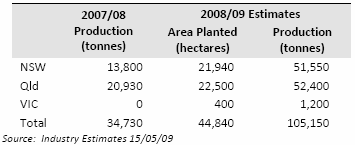Australia
May 09
Source:
Australian Oilseeds
Federation (AOF)
Canola 2009/10
 These
estimates are preliminary as not all planting has been completed
by this time. These
estimates are preliminary as not all planting has been completed
by this time.
NSW has had a good start to the season, particularly in
the north. April rains have left good sub-soil moisture in the
north and enabled sowing to commence on time in all districts.
Plantings in the north west (Walgett, etc) are the best they
have been for many years. Much of the state’s planting is now
complete, with estimates of 85%+ in the ground. Rainfall in the
second half of May will determine the extent of any further
plantings. In the central and southern districts early sown
crops have emerged well, while later sown crops have suffered
due to a loss of surface moisture, soil crusting and some frosts
resulting in patchy emergence. There has been some locust
damage to crops in the west (Nyngan, Warren, etc), with some of
the early emerging plants being damaged. At this stage of the
season there are no weeds problems evident across all districts.
Significant numbers of red legged earth mites are present in the
south but these are being effectively treated. With the early
break in the south a significant number of growers have taken
the opportunity to trial canola as a dual purpose grazing and
grain crop.
In Victoria, there has was reasonable rainfall in late
April but no appreciable follow up rain across the traditional
growing areas, leaving the higher rainfall parts of the state
being the main canola growing areas. In the drier areas, lack of
sub-soil moisture has significantly impacted plantings versus
last year (reports being down 50% in the Mallee, 30% in the
Wimmera), while in the Western District, planting is still
underway, with some recent rains (25mm) aiding germination. The
expectation is that plantings in this region will be down
slightly on the relatively high acreage recorded last year.
Overall state estimates do have some upside if there is good
rain in the next
7-10 days, although long range weather forecasts are not
positive, and this is impacting grower confidence to plant.
South Australia has had a good start to the season, with
planting currently underway. Eyre and Mid North/York have had a
very good start, and are looking to be similar to last year,
while the South East and Mallee will be down due to lack of
rain.
Western Australia has had below average rainfall to date,
with some patches of well below average falls. With the
exception of areas around Kwinnana, there has been very little
planting yet to kick off.
While higher prices have improved the chances of canola being
included in the rotation generally across the country, lack of
confidence in future rains is dampening grower confidence.
Soybean 2008/09
 Northern
Queensland crop has been affected by both insects and rain
which has knocked yield back significantly in recent weeks,
while further south, yields have been as strong as 4t/ha with an
overall average of 2.5. In the Downs, the harvest is nearly
complete, with variable yields averaging 2.5t/ha. Northern
Queensland crop has been affected by both insects and rain
which has knocked yield back significantly in recent weeks,
while further south, yields have been as strong as 4t/ha with an
overall average of 2.5. In the Downs, the harvest is nearly
complete, with variable yields averaging 2.5t/ha.
In NSW the north-west irrigated crop, grown mostly by
cotton growers, has delivered very good results with some crops
yielding just over 4 t/ha. Harvest is almost complete and yields
are some of the best average yields of the past decade. Dryland
yields on the northern tablelands and adjacent slopes have come
in about average. On the North Coast, harvest is nearly complete
(80-85%) with mixed results due to very wet conditions on the
coastal fringe, with yields overall ranging from 4.2t/ha where
conditions were favourable to 2t/ha where rain and rust have had
an impact.
Pricing differential this year between crushing and edible
market has been very small, so grower’s returns have been good,
despite quality issues. |
|